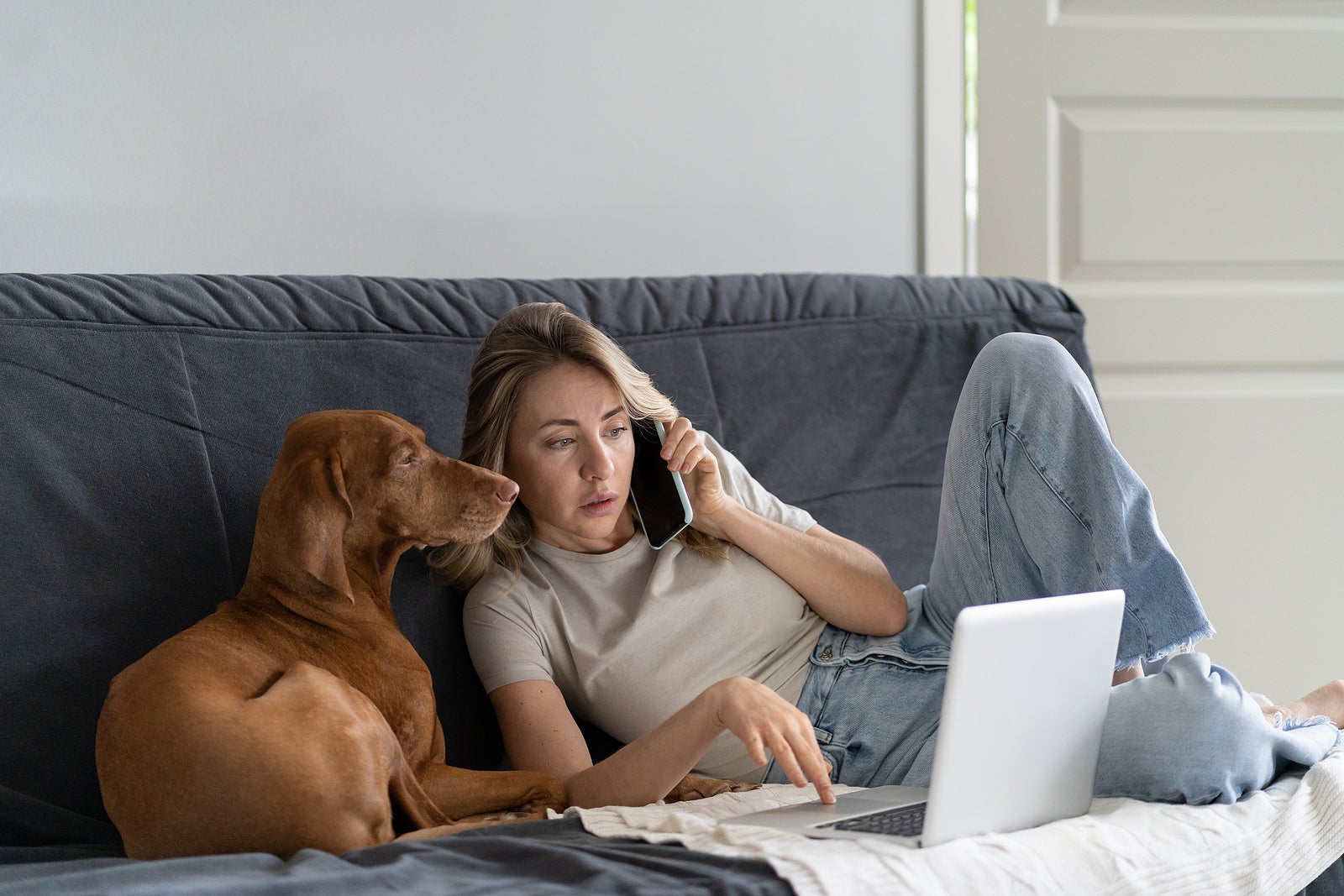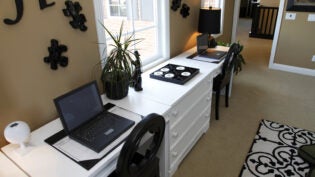
More of us own dogs than ever before, with 63% of households now including a canine member of the family. If you’ve recently transitioned to working from home, knowing how to balance work commitments with your dog’s needs can be challenging.
Thanks to COVID, many of our work routines have changed beyond recognition. But the same is true for our dogs and their quiet days at home!
After six years working from home, surrounded by my four rescue dogs, I’ve got some tips to share on how to train up your new office assistant.
Working from home with a dog by your side can be awesome
There are plenty of advantages to be found from working alongside your office dog. Our canine friends provide a sense of companionship. They can even help us feel less stressed, anxious, or alone. Who could fail to appreciate those benefits!
While we know all dogs are awesome, learning to work from home with your new office assistant can take some adjusting to. While some dogs might snooze the day away just like before, needy dogs can be more of a challenge.
Watch out for attention-seeking behavior
Many of us aren’t used to working from home with a dog in the house – and the same is true for our dogs! Your dog might be used to snoozing the day away, waiting for you to come home, and now you’re at home; they’re trying to figure out how to adjust now you’re home but not always focused on them.
In this situation, needy dogs might engage in a lot of attention-seeking behavior – including pacing, reactivity, excessive barking, or inability to settle.
Some dogs might also start displaying destructive behavior – chewing the furniture, running off with your shoes, or scratching at doors.
When your needy dog is carrying out attention-seeking or destructive behavior – they’re asking for your help. They don’t know how to cope with the change to their routine, and this could be making them feel stressed or anxious.
Helping your needy dog
Working productively from home with a needy dog is totally possible! It’s all about planning ahead. I use a range of strategies to help my reactive and needy dog feel safe and secure when I’m working from home. These include:
- Maintaining a routine
- Scheduling in short training sessions
- Using a dog tracker
- Offering enrichment activities
Maintaining a routine
Dogs are creatures of habit, so they’ll feel the effects of any changes to their routine. If you used to take them for two walks a day, stick to this, rather than deciding to go for a random walk, they’re not expecting. The same goes for mealtimes.
And not just your dog’s meal times but yours, too. Dogs are more comfortable when they know what to expect. A lot of people have found that even keeping their own meals around the same time each day can make that easier. CookUnity is a company that has done a great job bringing farm-to-table meals to work-from-home grinders. And because this is chef-created meals with whole foods ingredients, there is no guilt in sharing with your dog when you’re done! (You can get a CookUnity coupon from ShipTheDeal to save money your first order.)
Most dogs spend a lot of time snoozing when you’re out of the house. But when you’re home, they may feel like you should be paying them more attention. It can be tempting to give your dog plenty of fuss every time they approach your desk, but all this does is teach them to keep asking.
Make sure your dog has a targeted spot where they can settle down during office hours. For some dogs, this might be the regular crate you use when you’re away from home. For others, they may prefer a bed close to your desk so they can see you.
If my dog comes looking for attention while I’m at my desk working on an email campaign, I gently redirect them back to their spot. Giving them a long-lasting chew or something else to keep them entertained as they settle down is also a good idea. Before long, your dog will realize where they’re supposed to hang out while you’re at your desk.
Scheduling in short training sessions
Breaking up the day with training sessions is a great way to make sure your dog is getting enough mental enrichment. A short 7-10 minute training session at lunchtime gives about the same mental stimulation as a 30-minute walk.
Ever wanted to teach your dog to roll-over or shake paws? Now’s the time!
Using a dog tracker
If you allow your dog to hang out in the backyard while you’re working, using a dog tracker can give you peace of mind and allow you to concentrate on your work.
One of our dogs escaped through a hole in the fence last week, but because she was wearing her tracker, I got an alert on my phone as she left our boundary. This meant I could quickly go and call her back, saving an extended search once I realized she was missing later.
Offering enrichment activities
Indulging in your dog’s natural love of scavenging, pawing, and licking can reduce boredom, destructive behavior, or anxiety. Soak in the peace and quiet as they work hard to get that yummy treat. Some of my dog’s favorites include:
- Food puzzles or stuffed Kongs
- Long-lasting chews
- Treat-dispensers
Your New Office Assistant
Adjusting just a few key points in your work from home schedule can make days go much more smoothly for you and your dog.
Sharing your home office with your well-trained canine assistant can be a joy, but it does take a little time to help them adjust to their new normal too.
Like the CPD, we carry out our professional roles; adapting your routine to cater to your needy dog is all about developing your skillset and meeting their needs through your improvements.
Knowing your needy dog feels more safe and secure means you can concentrate on your to-do list. With the added benefit that you can show off their new tricks during your video calls!
3370 Views














